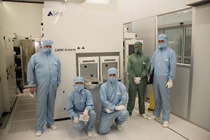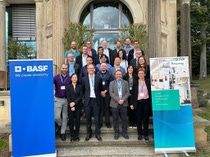Media
BASF and Fraunhofer IPMS celebrate ten years of R&D collaboration on innovative solutions in the field of semiconductor manufacturing
- Collaboration on improved materials for microchip interconnects
- Joint efforts on infrastructure and expertise allows efficient evaluation of improved chemicals and processes for chip integration at manufacturing-ready industrial scale
Ludwigshafen, Germany – October 22, 2024, BASF and the Fraunhofer Institute for Photonic Microsystems IPMS are proud to look back on ten successful years of cooperation. Together, they have been working on innovative and customized solutions in the field of semiconductor production and chip integration as part of their “BASF Plating-Lab”. Within pilot tests at the Center Nanoelectronic Technologies (CNT) of Fraunhofer IPMS, strategies are developed and implemented to make materials and technologies in semiconductor integration more efficient and cost-effective.
“With our cooperation, we are addressing the growing challenges in the market and thus enable new technologies in the field of interconnect and packaging,” explains Dr. Lothar Laupichler, Senior Vice President, Electronic Materials at BASF.
Process evaluation according to industry standard
Numerous electro-chemical processes are necessary during the manufacturing and integration of a microchip. Various layers of metal or metal alloys must be applied to the wafer to connect the individual circuits and create the network of conductor paths within a chip. For different steps in the overall integration and different subsequent applications, the chemicals and work steps must be adapted to individual processes of the customers. As part of the collaboration with BASF, new chemicals for electroplating deposition processes have been evaluated in recent years.
At the same time, corresponding product tests and demonstration trials have been carried out for customers at wafer level. BASF installed a state-of-the-art process tool in the clean room at Fraunhofer IPMS, which is operated by Fraunhofer’s experienced scientists. The cooperation partners are thus using the same tools that are applied in the industry processes. This enables customers to significantly reduce their qualification costs. As a result, development time and costs can be saved, and more efficient processes can be established. The innovative solutions can therefore be developed and evaluated directly under production conditions.
Direct application possibilities for industry partners
Over the past ten years, the project partners have achieved over 12,000 process runs. “The chemical packages and products developed can be used directly in our customers’ industrial processes,” says Dr. Benjamin Lilienthal-Uhlig, Head of Business Unit Next Generation Computing at Fraunhofer IPMS. For example, they are used to manufacture wiring structures in miniaturized circuits with dual damascene technology. The products are also important in the manufacturing of interposers, chiplets and 3D packages for rewiring structures (pillar, RDL, TSV) or they might form the metal layers in wafer-to-wafer hybrid bonding.
In June 2014, the chemical company and the research institute established the collaboration as part of the screening fab opened at CNT. Fraunhofer IPMS provides its 300mm cleanroom infrastructure to BASF for this purpose. Customers and partners also benefit from the Silicon Saxony network, in which the institute is located. It enables the involvement of other local facilities, such as the Dresden branch of Fraunhofer Institute IZM-ASSID, or direct process developments specifically for the global industrial partners of Fraunhofer IPMS (Bosch, Infineon, GlobalFoundries). The newly founded research center CEASAX (“Center for Advanced CMOS and Heterointegration Saxony”) will make it possible to work even closer on application-oriented solutions, especially with regards to the heterointegration of microsystems.
BASF’s Dispersions & Resins division
The Dispersions & Resins division of BASF develops, produces and markets a range of high-quality polymer dispersions, resins, additives and electronic materials worldwide. These raw materials are used in formulations for a number of industries, including coatings, construction, adhesives, printing and packaging, electronics and paper. With its comprehensive product portfolio and its extensive knowledge of the industry, the Dispersions & Resins division offers its customers innovative and sustainable solutions and helps them advance their formulations. For further information about the Dispersions & Resins division, please visit Dispersions & Resins (basf.com).
About BASF
At BASF, we create chemistry for a sustainable future. We combine economic success with environmental protection and social responsibility. Around 112,000 employees in the BASF Group contribute to the success of our customers in nearly all sectors and almost every country in the world. Our portfolio comprises six segments: Chemicals, Materials, Industrial Solutions, Surface Technologies, Nutrition & Care and Agricultural Solutions. BASF generated sales of € 68.9 billion in 2023. BASF shares are traded on the stock exchange in Frankfurt (BAS) and as American Depositary Receipts (BASFY) in the United States.
About Fraunhofer IPMS
The Fraunhofer Institute for Photonic Microsystems IPMS is a leader in applied research and development in the fields of intelligent industrial solutions, medical technology and mobility. Fraunhofer IPMS works on electronic, mechanical and optical components and their integration into miniaturized devices and systems. Its services range from design and product development to pilot production in its own laboratories and clean rooms. With the Center Nanoelectronic Technologies (CNT), Fraunhofer IPMS offers applied research on 300 mm wafers for microchip producers, suppliers, device manufacturers and R&D partners.
P-24-302



